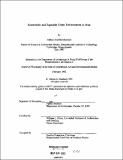Sustainable and equitable urban environments in Asia
Author(s)
Badshah, Akhtar
DownloadFull printable version (37.52Mb)
Advisor
William L. Porter.
Terms of use
Metadata
Show full item recordAbstract
This study identifies some of the factors and conditions that can encourage the development of sustainable and equitable urban environments. It argues that cities will continue to grow and that it is not productive to view that growth as a crisis or a tragedy; instead it must be seen as a challenge for the future. The urban policies that have evolved over the last several decades have combined the role of government agencies, private-sector investment, and community involvement. Projects undertaken in developing countries are often supported by international development agencies seeking to promote cooperative ventures through pilot or demonstration projects. This study, however, suggests that it is time to move on and to incorporate the lessons learned from these demonstrations into full -scale local and national urban-management strategies. Developing criteria for sustainable and equitable housing and urban services is the next goal. Among them, this study argues, is the need to reduce inequity in the way housing and urban services are planned and developed. To do this two interrelated approaches are suggested: one is to increase choices that the community is given and create conditions that promote community decision-making; the other is to optimize the role played by governments agencies, private-sector organizations, community groups, non-government agencies, and other local groups. Several projects in Asia and South Asia were evaluated to determine the process by which new housing programs are planned and developed, the kinds of decisions taken, and the roles played by the various participating groups. The role of non government organizations and community organizations in settlement upgrading programs; the advantages and risks of private sector involvement; and the potential role of community groups, non-government organizations, private developers, government agencies, and housing finance institutions in new housing projects, were also evaluated. The study concludes by showing that housing and urban-services programs have a better chance of becoming sustainable and equitable if they are developed through consensus rather than confrontation, and when private-sector involvement is encouraged and promoted under conditions that are clearly understood and instituted. The study also concludes that community accountability and decisionmaking must be increased, local-management promoted, and program components in which the community has a larger implementing role introduced. Similarly, the role of small-scale building contractors must be enhanced; and the needs of the broadened client groups understood and reflected in planning and design. Finally site design for urban developments has to be integrated into the larger community and respect the needs of its immediate surroundings. Many of the suggestions and proposals offered here are not broad strategies, but suggestions for feasible ways of improving society's chances of solving its urban development problems. They are not blueprints, but simply ideas for generating new approaches that will deal more adequately with the immediate and increasingly severe housing shortage, and recommend actions for preventing difficulties that may otherwise arise in the future. Finally, the recommendations in this study are strategic, not project-oriented; in their implementation the locus of responsibility rests with the cities themselves.
Description
Thesis (Ph. D.)--Massachusetts Institute of Technology, Dept. of Architecture, February 1993. Includes bibliographical references (p.371-389).
Date issued
1993Department
Massachusetts Institute of Technology. Department of ArchitecturePublisher
Massachusetts Institute of Technology
Keywords
Architecture